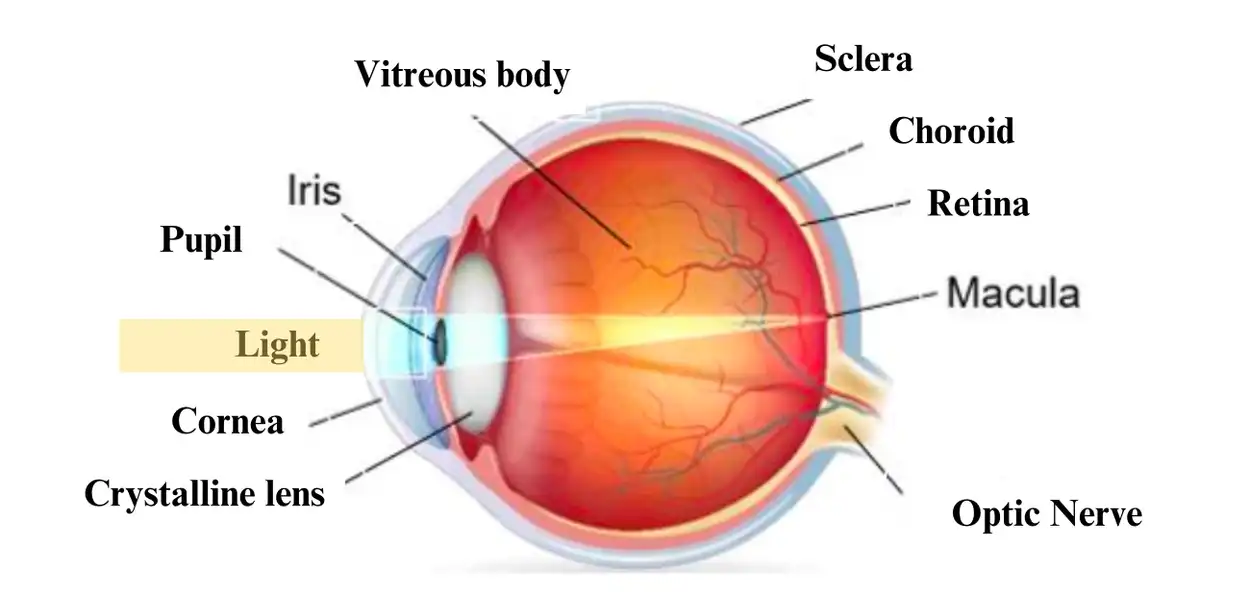The Impact of Physical Activity on Age-related macular degeneration (AMD) : Promoting Healthy Vision
Looking for a little motivation to start your morning jog? What if we told you it could help prevent AMD? In fact, this incurable disease, which is the main cause of poor eyesight in the elderly, could be delayed thanks to physical activity.

Understanding AMD
AMD is a progressive eye disease that affects the macula, the central part of the retina responsible for sharp, detailed vision. It leads to a gradual loss of central vision, impairing activities such as reading, driving, and recognizing faces. AMD can be classified into two forms: dry AMD, characterized by the buildup of drusen (yellow deposits) in the macula, and wet AMD, involving the growth of abnormal blood vessels beneath the macula.

Figure 1 Anatomy of the human eye
We have published another article where you can learn more about AMD and its risk factors.
The Role of Physical Activity in AMD Prevention
Research suggests that engaging in regular physical activity may help reduce the risk of developing AMD and slow its progression. A study published in the British Journal of Ophthalmology found that individuals who engaged in moderate-intensity aerobic exercise for at least three times a week had a significantly lower risk of developing AMD compared to sedentary individuals. The mechanisms behind this protective effect are not fully understood but are believed to involve improved blood flow to the retina and reduced oxidative stress.

Figure 3. Aerobic exercise may help reduce the risk of developing AMD and slow its progression.
Enhancing Blood Flow and Nutrient Supply
Regular physical activity, such as walking, cycling, or swimming, promotes cardiovascular health, which in turn improves blood flow throughout the body, including the eyes. By increasing blood circulation to the retina, physical activity helps deliver vital nutrients, oxygen, and antioxidants necessary for optimal retinal function. Adequate blood flow supports the removal of waste products and prevents the accumulation of damaging substances in the macula.

Figure 4. Regular physical activity improves blood flow
Reducing Oxidative Stress
Oxidative stress plays a significant role in the development and progression of AMD. Physical activity has been shown to reduce oxidative stress by enhancing the body's antioxidant defenses. Exercise stimulates the production of endogenous antioxidants, such as superoxide dismutase and glutathione, which help neutralize harmful free radicals and protect the retinal cells from oxidative damage. This antioxidant effect may contribute to the preservation of macular health and the prevention of AMD.
Maintaining a Healthy Weight and Managing Chronic Conditions
Regular physical activity also contributes to maintaining a healthy weight and managing chronic conditions, such as hypertension, diabetes, and cardiovascular disease.
These conditions are known risk factors for AMD, and their effective management through exercise and a healthy lifestyle can help reduce the risk of developing or worsening the disease. By promoting overall health and well-being, physical activity provides a multifaceted approach to AMD prevention.

Figure 5. Physical activity provides a multifaceted approach to AMD prevention.
Conclusion
As the prevalence of AMD continues to rise, adopting a physically active lifestyle becomes increasingly important. Engaging in regular exercise offers a range of benefits, including improved blood flow, reduced oxidative stress, weight management, and better management of chronic conditions. While physical activity alone may not guarantee protection against AMD, it plays a crucial role in promoting healthy vision and reducing the risk of developing this sight-threatening condition. Incorporating moderate-intensity aerobic exercise into daily routines, along with other healthy lifestyle choices, can contribute to a better quality of life and long-term eye health.
To learn more about how you can act on the modifiable risk factors such as nutrition to prevent AMD, you can visit www.macutest.com where you can have access to personalized lifestyle recommendations tailored to your real needs.
Bibliography
- Mauschitz MM et al. Physical Activity, Incidence, and Progression of Age-Related Macular Degeneration: A Multicohort Study. Am J Ophthalmol. 2022
- « What Is Macular Degeneration ? » , American Academy of Ophthalmology, 6 avril 2023.
- « Age-Related Macular Degeneration (AMD) » , Johns Hopkins Medicine, 8 août 2021.
- M. B. McGuinness et al., « Physical Activity and Age-related Macular Degeneration : A Systematic Literature Review and Meta-analysis » , American Journal of Ophthalmology, août 2017.
- « How to improve and boost circulation | AxA Health » , AXA Health.
- L. Streese et al., « Physical activity and exercise improve retinal microvascular health as a biomarker of cardiovascular risk : a Systematic review » , Atherosclerosis, déc. 2020
- « Aspetar Sports Medicine Journal - Exercise and Oxidative Stress : an exercise paradox ? »
- C. Simioni et al., « Oxidative stress : role of physical exercise and antioxidant nutraceuticals in adulthood and aging » , Oncotarget, mars 2018.
- « Benefits of physical activity » , Centers for Disease Control and Prevention, 14 juin 2023.
- E.-C. Lindgren et al., « Empowerment-based physical activity intervention for people with advanced dry age-related macular degeneration : Mixed-methods Protocol » , International Journal of Environmental Research and Public Health, déc. 2022.
The link between Age-related Macular Degeneration (AMD) and Alzheimer's Disease
Age-related Macular Degeneration (AMD) and Alzheimer's disease are two significant health concerns among the aging population. While these conditions primarily affect different organs—the eyes and the brain, respectively—emerging research has suggested a potential link between AMD and Alzheimer's.
The effects of high blood pressure on the eye
Age-related macular degeneration(AMD) and high blood pressure are two common health problems that often affect the elderly. Although they may seem unrelated at first glance, recent studies have revealed intriguing links between the two conditions.